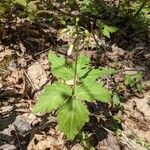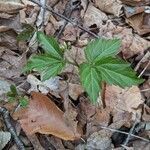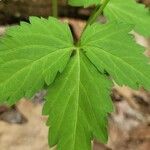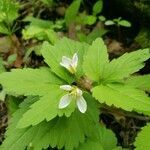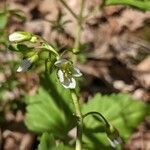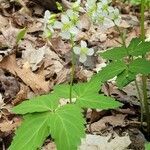Perennials; usually glabrous, rarely sparsely pubescent. Rhizomes (unsegmented), cylindrical, 2-10 mm diam., (somewhat uniform, fleshy, not fragile, with dentate leaf scars). Stems erect, unbranched, (1.2-)1.5-3.5(-4) dm, rarely sparsely pubescent distally. Rhizomal leaves 3-foliolate, (5.5-)8-22(-26) cm, leaflets petiolulate or subsessile; petiole (3-)4.5-16(-20) cm; lateral leaflets subsessile or petiolulate, blade often similar to terminal, base sometimes oblique; terminal leaflet (petiolule 0.5-1.2 cm), blade ovate-elliptic to broadly ovate, (2-) 3.5-8(-10) cm × (5-)20-65(-80) mm, base cuneate to obtuse, margins coarsely crenate or dentate, (surfaces puberulent, trichomes to 0.1 mm). Cauline leaves 2 (or 3) [(sub)opposite], 3-foliolate, (similar to rhizomal leaves), petiolate, leaflets petiolulate or subsessile; petiole (1-)2-4.5 cm, base not auriculate; lateral leaflets similar to terminal; terminal leaflet subsessile or petiolulate (0.2-1 cm), blade broadly elliptic to ovate, (2-)4-8(-10) cm × 10-50 mm, margins coarsely dentate or crenate, (margins minutely puberulent). Racemes ebracteate. Fruiting pedicels ascending to divaricate, (10-)15-30 (-36) mm. Flowers: sepals oblong, (4-)5-8 × 2-3 mm, lateral pair slightly saccate basally; petals white or pink to purple, obovate to oblanceolate, (7-)9-15(-17) × (3-)4-7 mm, (short-clawed, apex rounded); filaments: median pairs 5-8 mm, lateral pair 3.5-6 mm; anthers linear to oblong, 2.5-3 mm. Fruits linear-lanceolate, 1.5-4 cm × 1.5-2.5 mm; ovules 10-14 per ovary; style 4-8(-10) mm. Seeds (rarely produced) brown, oblong, 2-2.2 × 1.2-1.5 mm (cotyledons incumbent). 2n = 96.
More
Rhizome continuous; stem glabrous, 2–4 dm; cauline lvs commonly 2, opposite or nearly so; lfls 3, coarsely crenate-toothed, half as wide as long, the terminal rhombic-ovate, the lateral obliquely ovate, obtuse to rounded at base on the broad outer side; basal lvs similar to the cauline; hairs of the lf-margins appressed, very short, ca 0.1 mm; sep 5–8 mm; pet 11–17 mm, dull purplish; frs 2–4 cm; 2n=96. Rich woods; Que. and N.B. to Minn., s. to N.C., Ga., and Ala. Apr., May. (Dentaria d.; D. incisa, a form with narrower, laciniately toothed lfls.)
A small herb. It grows 20-40 cm tall. The rhizome of underground stem has teeth. The lower leaves are mostly compound. The leaves on the stem are in pairs and have teeth. These are each divided into 3 broad leaflets.
